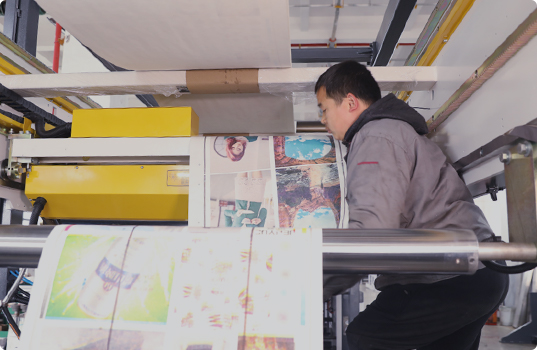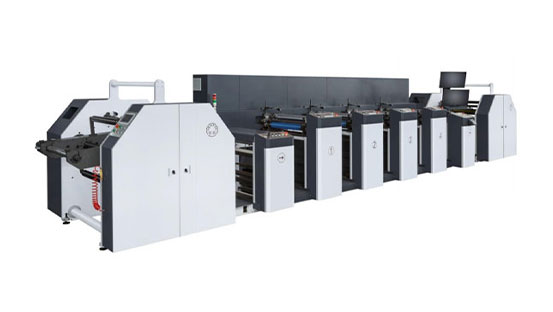 Jun 20, 2025
Jun 20, 2025
Visit:1368
 Jun 20, 2025
Jun 20, 2025
Visit:1368
In the field of printing, Flexo printing, as a unique process technology, occupies an important position and is widely used in many industries such as packaging and labels. An in-depth analysis of its advantages and disadvantages is of great significance to printing practitioners and related industries.

Flexo printing can be regarded as a model of environmentally friendly printing, especially in the use of ink. Water-based ink is its common type, using water as a solvent, which greatly reduces the emission of volatile organic compounds (VOCs). In the context of increasingly stringent environmental regulations and the popularization of the concept of green development, this feature makes it stand out. Taking food packaging printing as an example, water-based ink eliminates harmful solvent residues, which not only ensures the purity of food from pollution, but also makes the air in the packaging workshop fresh and pleasant. Workers do not need to worry about inhaling harmful gases, and the surrounding environment is also free from pollution.
The quality of Flexo printing is comparable to other mainstream printing methods. With the continuous advancement of science and technology, modern flexographic platemaking technology has become increasingly sophisticated, and the resolution of the printing plate has been greatly improved, which can accurately reproduce delicate lines, tiny text and complex patterns. In the label printing scenario, the dosage instructions on the drug label and the delicate patterns on the cosmetic label can all be clearly presented without any blur or ghosting. Its color management system is also excellent. By accurately adjusting the flow and color ratio of the ink, the colorful colors in the design draft can be perfectly restored. The finished product is full of color, distinct layers, and full of visual impact.
The compatibility of this printing method is remarkable, and the printing materials are almost "all-inclusive" in front of it. Paper types include cardboard, corrugated paper, etc. When cardboard is used to make high-end gift boxes, Flexo printing gives it a beautiful appearance; corrugated paper is transformed into a striking transport packaging box after Flexo printing. Plastic films such as polyethylene and polypropylene are commonly used in snack packaging bags and plastic wrap. Flexo printing firmly inks on them, and the patterns are long-lasting and bright. Even composite materials can be easily controlled, such as the aluminum-plastic composite tube of toothpaste, which has complete information and beautiful appearance after printing. Whether it is a small label, a medium-sized leaflet, or a large-format outdoor poster, Flexo printing can be done with ease and accurately.
Compared with some high-end printing equipment, the price of Flexo printing machines is more affordable. For small and medium-sized enterprises with limited funds, the purchase cost will not be a heavy burden, allowing them to easily enter the printing business field. The equipment structure is simple and intuitive, and the operation process is simple and easy to learn. New employees can get started after a short training. Daily maintenance does not require a professional team. Ordinary maintenance personnel can complete basic maintenance tasks such as replacing ink rollers and cleaning scrapers with the help of conventional tools and in accordance with the instructions, which greatly reduces labor costs and technical barriers.
Flexo printing performs well in speed, especially when facing roll materials, just like a high-speed printing engine. In the newspaper printing workshop, the Flexo printing machine rotates rapidly, and the paper shuttles like water. In a short period of time, a large number of newspapers are freshly produced and delivered to readers in a timely manner. On large-scale packaging material production lines, cartons and rolls of film are quickly printed, efficiently meeting the huge demand for packaging in industries such as fast-moving consumer goods and e-commerce, and effectively promoting the rapid flow of products to the market.
The flexographic material makes it less wear-resistant. Under high-speed and high-pressure printing conditions, the graphic details of the printing plates are the first to be worn. Just like the soles of shoes that are frequently walked on, the patterns will gradually become blurred over time. Taking large-scale carton printing as an example, when the order volume reaches hundreds of thousands of pieces, the printing plates may be "overloaded" halfway, the clarity of the graphics and text will decrease, and the color uniformity will be damaged. At this time, the printing plates have to be stopped and replaced, which not only consumes the cost of new printing plates, but also leads to production interruptions, delays in construction, and additional time and financial costs.
Although Flexo printing has good color expression, it is not easy to accurately control the color. Compared with offset printing, Flexo printing is affected by many factors. For example, the viscosity of ink is affected by temperature and humidity. When the temperature in the workshop rises, the ink becomes thinner and the color concentration decreases. When the humidity increases, the ink dries more slowly, and ink bleeding is prone to occur. Wear or blockage of the anilox roller will cause inaccurate ink transfer and unbalanced color matching. In addition, slight differences in the raw materials of different batches of ink may also cause the color of the finished product to fluctuate, making it difficult to consistently meet the strict color standards of customers. This shortcoming is particularly difficult for products with extremely high requirements for brand consistency, such as high-end cosmetic packaging.
Flexo printing seems to be unable to achieve certain special printing effects. Effects such as metallic texture and fluorescent special effects can be easily achieved by offset printing or special printing techniques, but Flexo printing is difficult to perfectly present due to technical limitations. For example, the cool brushed metal effect on the packaging of electronic products can only be admired by Flexo printing; the effect of fluorescent logo shining in the dark is eye-catching, but Flexo printing tries to simulate it but it is not satisfactory, which is difficult to meet the needs of customers who pursue unique visual experience, limiting its expansion in the field of creative high-end packaging.
Flexo printing has gained a firm foothold in the printing market with many advantages, and widely serves in the fields of daily packaging, basic label printing, etc. However, its shortcomings also restrict its progress towards higher precision and personalization. In the future, with the continuous innovation of materials and technologies, Flexo printing is expected to make up for its shortcomings, expand the boundaries of application, and continue the legend of printing.

HJ-650/950 Servo Horizontal Flexo Printing Machine
Flexo printing advantages: suitable for batch printing, fast speed, low cost, suitable for a variety of materials, strong ink compatibility. Disadvantages: low precision (150-300dpi), high plate making cost, time-consuming plate changing, poor expression of complex patterns. The development prospects of Flexo printing are still broad and full of hope. With the rapid progress of science and technology, scientific researchers are going all out to overcome the current difficulties. In the research and development of printing plate materials, new high-strength and high-wear-resistant resin materials have emerged, which is expected to greatly extend the life of printing plates and reduce the cost and efficiency loss caused by frequent replacement of printing plates. The intelligent color management system is also being intensively developed and upgraded. With the help of advanced sensors and automatic control devices, it can monitor and accurately adjust key factors such as ink viscosity and anilox roller status in real time to ensure consistent colors and ensure that every print can accurately meet customer color expectations.
 Nov 01, 2025
Nov 01, 2025
FLEXO PRINTING MACHINE
FLEXO PRINTING MACHINE
FLEXO PRINTING MACHINE
GET A QUOTE